SBI PO (Main) Exam Paper - 2017 "Data Analysis and Intelligence"
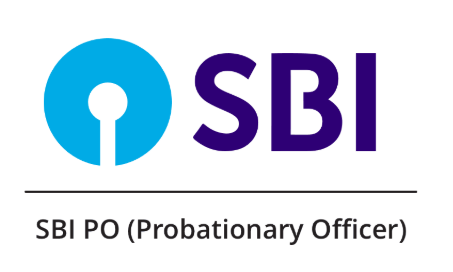
SBI PO (Main) Exam Paper - 2017 "Data Analysis and Intelligence"
Direction (76-80): Study the data given below and answer the following question. The pie charts shown below shows the distance covered by a boat moving upstream and downstream in different days of a week. And the table shows the speed of stream in km/hr. in different days of a week.
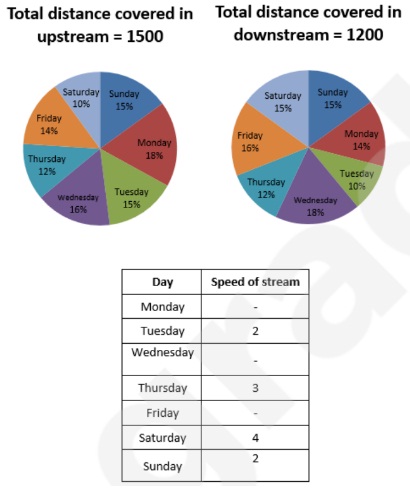
76. If the time taken by boat to travel upstream on Sunday is equal to the time taken by it totravel downstream on Thursday and the speedof boat in still water on Thursday is 13 kmph then find the speed of boat in still water on Thursday?
A. 27 kmph
B. 25kmph
C. 26 kmph
D. 28 kmph
E. Can’t determine
77. If the time taken by boat to travel upstream on Monday is 20 2/5 hrs more than the time taken by it to travel downstream on the same day, then find the speed of boat in still stream on Monday if speed of boat in still water is 10 kmph
A. 2.2 kmph
B. 1.8 kmph
C. 2.0 kmph
D. 2.5 kmph
E. Can’t be determined
78. If the speed of boat in still water on Friday was 22 km/hr and the speed of boat in still water on Tuesday was 10/11 times of Friday and time taken to travel downstream on Friday is 20/11 hrs more than the time taken by it to travel downstream on Tuesday, then find the speed of stream (in kmph) on Wednesday?
A. 1.5
B. 2
C. 4
D. None of the above
E. Can’t be determined
79. The speed of boat in still water on Saturday was 20 km/hr. if the time taken by boat to travel downstream on Saturday is 25/32 times taken to travel upstream on Sunday, then find the time taken by the boat to cover a distance of 21.25 km upstream when the speed of stream is same as that of Sunday.
A. 3 hrs.
B. 2.5 hrs.
C. 4 hrs.
D. None of these
E. Can’t be determined
80. If the time taken by boat to travel upstream on Sunday is 6 hours more than the time taken by it to travel downstream on Thursday and the speed of boat in still water on Thursday is 13 kmph, then find the upstream speed of boat on Sunday?
A. 17 kmph
B. 20 kmph
C. 12 kmph
D. 15 kmph
E. Can’t be determined
Direction (81-84): There are three bags A, B and C. In each bag there are three types of coloured balls Yellow, Green and Black. In bag A, no. of yellow coloured balls are y and no. of green coloured balls are g. Number of green coloured balls are 4 more than the number of yellow coloured balls. When one ball is picked at random then the probability of getting black colour ball is 5/13 , The value of y is 18 2/11% less then g. In bag B, number of yellow coloured balls is 22 2/9% more than that of bag A. If two balls are picked at random from bag B then the probability of getting both green colour ball is 4/37 . Total number of balls in bag B is 75. In bag C, the ratio of number of green coloured balls and number of black coloured balls is 7 : 5. Total number of green and black coloured balls is 36. If one ball is picked at random then the probability of getting one yellow ball is 7/13.
81. If x number of yellow balls from bag B are taken and placed into bag A and 20% of black balls from bag A are taken and placed into in bag B. If we pick one ball from bag B then the probability that the ball is of black colour is 11/26 . Then find the value of x?
A. 2
B. 4
C. 1
D. 1/2
E. 3/2
82. If one ball picked at random from each of the bag A and bag B then find the probability that both of the balls are of the same colour?

83. Difference between the number of green balls in bag A and bag C is how much percentmore/less than the sum of the number of black balls in bag A and bag C together?
A. 97.5%
B. 91%
C. 75%
D. 79.5%
E. None of the above
84. Ram counted balls in Bag C and Bag A but mistakenly he counted green balls in bag B instead of C. What is error percentage (approx.)?
A. 3%
B. 2%
C. 5%
D. 4%
E. 1%
Directions (85-86): Each of A, B, C and D need a unique time to do a certain work. A can do the work in x days and B can do the work in 2x days. A started the work and do it for 22 2/9 days then he is replaced by B and B completed remaining work in same time as C and D together can complete the whole work. The ratio of the efficiency of C and D is 4 : 5.
85. If C and D work for alternative days starting from C then they can do the total work in 44 1/2 days. Then find x value?
A. 33.33
B. 66.66
C. 30
D. 70
E. 80
DOWNLOAD SBI PO Question Papers PDF
DOWNLOAD SBI CLERK Question Papers PDF
DOWNLOAD MORE BANK EXAMS E-BOOKS
Printed Study Material for SBI PO Exam
86. If E and F together work for 24 days then they are replaced by A and B respectively then they can do the remaining work in 20 days. If the efficiency of E and F is 5 : 4, If E and F together complete the whole work then find the difference between the work done by E alone and the total work done by F alone ?
A. 1/7
B. 1/9
C. 1/6
D. 3/7
E. 1/3
87. ABCD is a trapezoid. PQRS and MLKJ are two rhombus. Diagonal of PQRS are 6 cm and 8 cm. One of the angle of MLKJ is 120 degree and the diagonal bisecting that angle measures 15 cm. Side of PQRS = AB, side of MLKJ = CD. Find MN (median of trapezoid)
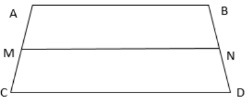
A. 15
B. 20
C. 10
D. 12
E. Can’t determine
88. A vessel contains 2.5 litres of water and 10 litres of milk. 20% of the contents of the vessel are removed. To the remaining contents, x litres of water is added to reverse the ratio of water and milk. Then y litre of milk is added again to reverse the ratio of water and milk. Find y.
A. 128
B. 120
C. 60
D. 30
E. 130
Directions (89-92): A,B,C,D and E are five persons to complete jobs X and Y. Line graph shows the data regarding the number of days taken by these persons to complete the job X and Y.
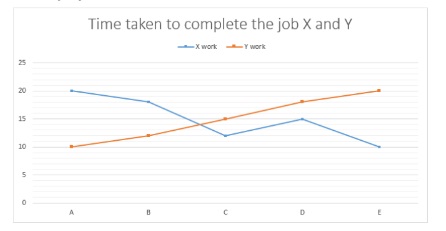
89. A and B working on job Y alternatively for 10 days. C and D worked alternatively for n days. If 1/15 of the job is remained then how many days c alone can finish the job?
A. 14
B. 12
C. 13
D. None of the above
E. Can’t be determined
90. If A worked on job X for 5 days each and C worked for 3 days. the remaining job was done by E and D. If the ratio of the number of days for which D and E worked is in ratio 1:1, then find the number of days for which C,D and E worked?
A. 6
B. 3
C. 9
D. 5
E. Can’t be determined
91. If the ratio of the number of days for which D and C worked on job Y is 12:5 and completed the work then find the difference between number of days for which C and D worked.
A. 7
B. 14
C. 21
D. Can’t be determined
E. All of above
92. If B worked on job Y with 4/9 times his work efficiency and assisted by D every 3rd day then find the number of days for which B and D worked to complete the job.
A. 18
B. 13
C. 16
D. 12
E. None of the above
Directions (93-96): Find the correct relationship between the given quantities:
93. Quantity 1: Find A value where S is an acute angle and PQ||RS
Quantity 2: A=25

A. Quantity 1 < Quantity 2
B. Quantity 2 < Quantity 1
C. Quantity 1 = Quantity 2
D. Can’t establish a relation
E. None of the above
94. There are 63 cards in a box numbered from 01 to 63. Every card is numbered with only 1 number.
Quantity 1: Probability of picking up a card whose digits, if interchanged, result in a number which is 36 more than the number picked up.
Quantity 2: Probability of picking up a card, the number printed on which is a multiple of 8 but not that of 16.
A. Quantity 1 < Quantity 2
B. Quantity 2 < Quantity 1
C. Quantity 1 = Quantity 2
D. Can’t establish a relation
E. None of the above
95. Quantity 1: Number of hours in which A, B and C can complete the work if A, B and C alone can finish it in 25, 20 and 15 hours respectively.
Quantity 2: Number of hours in which B can finish the work if A working alone finishes it in 20 hours while working together they finish it in 5 hours.
A. quantity 1 > quantity 2
B. quantity 1 ≥ quantity 2
C. quantity 1 ≤ quantity 2
D. quantity 1 < quantity 2
E. quantity 1 = quantity 2
DOWNLOAD SBI PO Question Papers PDF
DOWNLOAD SBI CLERK Question Papers PDF
DOWNLOAD MORE BANK EXAMS E-BOOKS
Printed Study Material for SBI PO Exam
96. Quantity 1: In an examination, Ankita scored 35 marks less than Puneeta. Puneeta scored 65 more marks than Meenakshi. Rakhi scored 115 marks, which is 20 marks more than Meenakshi's. Simpy scored 108 marks less than the maximum marks of the test. What approximate percentage of marks did Simpy score in the examination, if she got 67 marks more than Ankita?
Quantity 2: The length of a rectangle is increased by 60%. By what percent would the width have to be decreased to maintain the same area?
A. Quantity1 < Quantity2
B. Quantity1 ≤ Quantity2
C. Quantity1 ≥ Quantity2
D. Quantity1 > Quantity2
E. None of these
97. Directions: The question given below is followed by two statements. You have to determine whether the data given in the statements are sufficient for answering the question. You should use the data and your knowledge of Mathematics to choose between the possible answers. How many students from institute 'A' got the placement?
I. Number of students studying in institutes A and B are in the ratio of 3:4 respectively.
II. Number of students who got placement from institute B is 120% of the number of students who got placement from institute A
III. 80% of the students studying in institute B got placement.
A. I and II both
B. Only I
C. Only II
D. Any one of the three
E. Question cannot be answered even with the information in all three statements
98. Direction: The question given below is followed by some statements. Read the question carefully and determine which of the given statements is/are necessary/required to answer the question.
What is the cost of flooring the rectangular hall?
I. Length and the breadth of the hall are in the ratio of 3:2
II. Length of the hall is 48 m and cost of flooring is 850 Per sq.m.
III. Perimeter of the hall is 160 m and cost of flooring is 850 per sq m
A. I and II
B. I and III
C. Only III
D. I and either II or III
E. Any two of the three
99. Directions: The question given below is followed by two statements. You have to determine whether the data given in the statements are sufficient for answering the question. You should use the data and your knowledge of Mathematics to choose between the possible answers.
What is the rate of interest Percent per annum?
I. An amount doubles itself in 5 yr on simple interest.
II. Difference between the compound interest and the simple interest earned on a certain amount in two years is 400.
III. Simple interest earned per annum is 2000
A. Only I
B. II and III
C. Any two of three
D. Either I alone or II and III together
E. Either I and II or I and III
100. Direction: The question given below is followed by some statements. Read the question carefully and determine which of the given statements is/are necessary/required to answer the question.
Find the two-digit number?
I. The difference between the number and the number formed by interchanging the digit is 27
II. The difference between two digits is 3.
III. The digit at unit's place is less than that at ten's place by 3
A. I and III
B. I and either II or III
C. II and III
D. All of these
E. None of these
101. Directions: The following question is followed by few statements. You have to study the question and all the statements given and decide whether the information provided in the statement(s) is sufficient/required to answer the question or not: If k is an integer and x(x – k) = k + 1, what is the value of x?
I. x < k
II. x = k + 1
III. x = 3 – k
A. Only statement I is sufficient.
B. Only statement II is sufficient
C. Any of the two statements out of I, II and III are sufficient
D. All three are together sufficient
E. None of these
Direction (102-106): Study the given table carefully and answer the questions that follow.
Given below is a table which tells us about the profit or loss% made on 4 items sold by 6 companies, A, B, C, D, E, and F. Some of the data is missing in the table which one has to calculate using the given data.
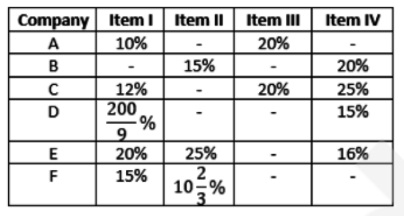
102. The ratio of the selling price of item I and II for company A is 4 : 3. Find the profit or loss% made on item II if the ratio of their cost price was 8 : 9. It is known that company A made profit on item I.

103. The marked price of items are same for each company. The marked price of items are: Item I – Rs. 2500, item II – Rs. 1750, item III – Rs. 2400, item IV – Rs. 3200. For company C, a discount% of 10% is given on item III while two successive discounts of the equal % was given on item I by company D. Find the successive discount% given by company D if the cost price paid by company C for item III was equal to the cost price paid by company D for item I. Company C made profit on item III while company D suffered loss on item I.
A. 15%
B. 12%
C. 20%
D. 16%
E. 25%
104. Company F marked item IV at 25% higher than its cost price. Selling price of this item is Rs. 4140. Find the marked price of item IV, if ‘d’ is discount% and profit% made by selling the item is (3d – 9)%.
A. Rs. 4400
B. Rs. 4500
C. Rs. 4680
D. Rs. 5140
E. None of these
105. The selling price of the items sold by Company E was Rs. 2400, Rs. 2100, Rs. 1870 and Rs. 2030 in the order from I to IV. They made a profit on items I and IV while they lost money on item II. Find the profit or loss made on item III if the company made an overall profit of 5% by selling all the items.
A. Rs. 200
B. Rs. 400
C. Rs. 500
D. Rs. 420
E. Rs. 560
106. The average selling price of item I sold by company C and company A is Rs. 3493. The cost price of the item I for company A and company C is in the ratio of 5 : 4. Find the % by which the selling price of this item sold by Company C is greater or less than the selling price of this item sold by company A. Both companies made profit on the item.
A. 17.2%
B. 18.54%
C. 19.25%
D. 20.6%
E. 21.36%
Directions (107-108): The following information should be used to solve the following 2 questions. The information given in a question or the answer may be used in the other question as the 2 questions are linked. Please solve carefully before proceeding:
3 partners – A, B, and C – invested in a business through different means – cash capital, land assets and equity certificates. Cash invested by the 3 were in the proportion 2:3:7 respectively; land assets were invested in the ratio 4:3:5 respectively; and equity certificates were invested in proportion 1:5:4 respectively.
107. If total cash invested was Rs. 42 lakhs, total land worth invested was Rs. 93 lakhs, total value of equity certificates was Rs. 65 lakhs, and all invested for the same time, then what will be profit share of ‘A’ if the total profit at the end of 1st cycle is Rs. 1.5 crores?
A. Rs. 45.65 lakhs
B. Rs. 37.755 lakhs
C. Rs. 33.375 lakhs
D. Rs. 29.895 lakhs
E. None of the above
108. In the next cycle the investments made were doubled but in the same proportion as in the previous cycle. However, the period they were invested changed for this cycle. A invested for 10 months, B invested for 2.5 years and C invested for 20 months. What is C’s approximate profit share if the total profit this time was Rs.3 crores?
A. Rs. 2.25 crores
B. Rs. 2.50 crores
C. Rs. 1.63 crores
D. Rs. 1.27 crores
E. Rs. 2.22 crores
Direction (109-110): Study the following information carefully and answer the question given billow:
Two trains A & B are travelling in the same direction at a certain speed. Length of thetrain A is 300 metres and the speed of the train B is 30km/hr. The train A passes a man who is walking at a speed of 4km/hr along the line in the same direction as ‘A’ in 30 seconds.
109. If the train A reached the station in 15 minutes after it had passed the man. In what time the man reached the station?
A. 1 hour
B. 1.5 hours
C. 2 hours
D. 2.5 hours
E. Data insufficient
110. If the train A passes the train B completely in 5.4 minutes find the length of the train B in metres?
A. 500m
B. 750m
C. 822m
D. 850m
E. 600m

